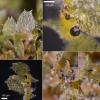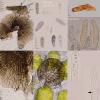
15-12-2025 21:11
 Hardware Tony
Hardware Tony
Small clavate hairs, negative croziers and IKI bb

15-12-2025 15:54
 Johan Boonefaes
Johan Boonefaes
Unknown anamorph found on the ground in coastal sa

15-12-2025 15:48
 Danny Newman
Danny Newman
Melanospora cf. lagenaria on old, rotting, fallen

15-12-2025 07:05
 Danny Newman
Danny Newman
Pseudosclerococcum golindoi (det: Zotto)near Cosb

15-12-2025 11:49
 Danny Newman
Danny Newman
ITS sequences from the following two collections B

15-12-2025 07:09
 Danny Newman
Danny Newman
indet. Rutstroemiaceae sp. on unk. fallen leavesMc

15-12-2025 12:34
 Danny Newman
Danny Newman
indet. Rhytismataceae on oak leafnear Purchase Roa

09-12-2025 12:06
 Andgelo Mombert
Andgelo Mombert
Bonjour,Je recherche l'article concernant Hypobryo
Hi to everybody
Searching for helotiales on liverworts we have found these very minute (70-100 microns), superficial, scattered, ostiolate, brownish black thyriothecia (i feel they are so by the type of tissue) on decaying thallus of I pressume Lophocolea bidentata. The bitunicate asci are oligosporic, perhaps only 4-spored. Ascospores hyaline or subhyaline, 1-septate.
Have you some idea for help me?
Many thanks again
Did you get anywhere with this? It looks related to Lichenopeltella alpestris s.l. found on Plagiochila asplenioides (see Marsh et al., 2010) but is clearly distinct as it lacks the papilliform cells on the ostiole neck and the asci are 4-spored.
George
Nothing. I had even forgotten about it. But since you're talking about it, do you have a description of this fungus you're talking about in IMI Descr. Fungi Bact. 174(nos 1731-1740): [2] (2007)?
I only have this https://karstenia.fi/ascomycetes-and-anamorphic-fungi-growing-on-plagiochila-hepaticae-in-finland/ - I have collected this on Plagiochila asplenioides and once on dead Polytrichum commune antheridial cups. We think it may be colonising the cuticle, perhaps with a broad host range.
And a documentation of my collection here https://fungi.myspecies.info/all-fungi/lichenopeltella-sp-p4998 - it is distinct from the true L. alpestris.
Hope this helps,
George
I will keep on waiting

I found what seems to fit L. fimbriata and also L. alpestris sensu Racovitza on the abaxial leaf surfaces of Polytrichum commune antheridial cups. The former is particularly interesting given that it was only found on conifer leaves in the past, and the latter seems to grow on several moss and liverwort hosts. Maybe this suggests wide host preferences for some members of the group - they are often on waxy parts of host plants.
https://bryophilous.co.uk/lichenopeltella-sp/
It could even be worth checking the lichenicolous ones for candidates for this collection - a previous post on this forum suggests that a species was found both on Cladonia and surrounding spruce needles. http://www.ascofrance.com/search_forum/52475
Racovitza (1959) also includes L. cetraricola as recorded on a liverwort, and Aulographella muscicola on a moss. Yours is different to both of these as well.
I still need to read more about the many lichenicolous ones...
All the best,
George

